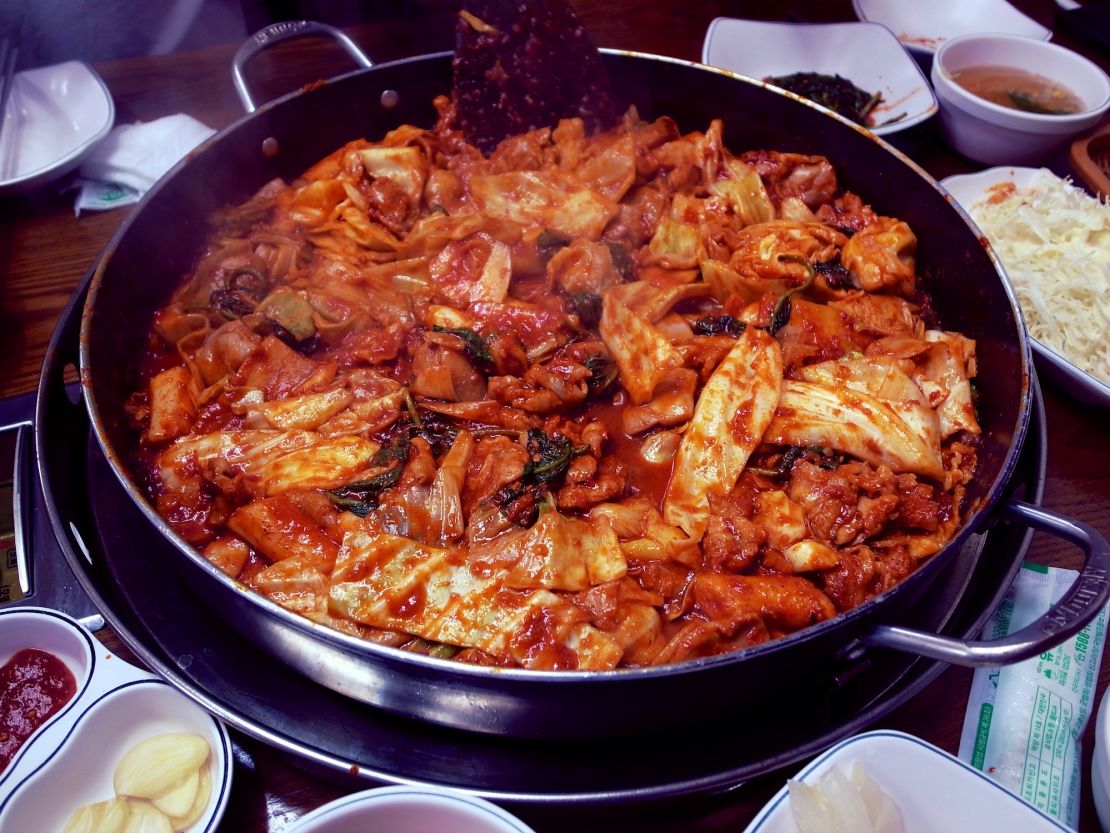While all eyes are on South Korea’s Gangwon Province for the PyeongChang 2018 Olympic Winter Games, the promise of spicy, stir-fried South Korean chicken has turned our gaze to the regional capital of Chuncheon.
As the region’s most popular dish, dak-galbi is one of those warming winter meals that’s best shared with the entire family.
Prepared atop a cast-iron skillet in the center of the table, the jumble of ingredients includes marinated chicken, cabbage, sweet potatoes, perilla leaves (from the mint family) and tteok bokki (Korean rice cakes) – all topped with sweet and spicy gochujang sauce (a fermented Korean chili paste).
But dak-galbi isn’t just a cheap, ubiquitous meal. Emerging in the 1960s after the Korean War, “commoner’s galbi” has become a symbol of the city’s resilience.
“I hope people don’t come to Chuncheon just to eat dak-galbi without understanding its history,” Choi Jeong-Yern, owner of a second-generation dak-galbi restaurant in Chuncheon, tells CNN Travel.
“I hope people learn that Chuncheon’s iconic dish was created out of the pain that people carried after the war. This is a local food that has a history and a story.”
The dak-galbi story
On June 25, 1950, the Korean War began with the Battle of Chuncheon, where a series of attacks all but leveled the city.
“After the war, chicken farms became the livelihood of people who were poor and almost begging on the streets,” says Jeong-Yern. “There was agony and pain, even after the conflict was over.”
During this dark era, dak-galbi was a happy discovery. The dish made use of cheap, copious ingredients, creating something comforting and communal that brought people together.
“The story of dak-galbi started from a couple who were running a popular pork restaurant in the 1960s,” Park Sung-Soo, a Chuncheon culture tour guide, tells CNN Travel.
“One day, they ran out of pork and decided to use chicken, which was cheaper and more abundant. They stir-fried the chicken in the same way as the pork, and the dish was a hit.
“Other people started serving the same dish, one after another, and eventually there were many dak-galbi restaurants in Chuncheon.”
Where to find it

Dalk-galbi became so symbolic of Chuncheon that the city dedicated an entire road – MyeongDong Dakgalbi Street – to the purveyors.
Travelers can wander the aromatic lane, choosing between tiny family-run restaurants.
Even though there are dozens of restaurants on MyeongDong Dakgalbi Street, Jeong-Yern says each one has its own style.
“Every restaurant in this historic alley contributes its own special taste to the dish,” she notes.
“Our restaurant’s dak-galbi is light and not too spicy, which is something we’re proud of. I think of dak-galbi as my own history. My parents started this restaurant, handed it to me, and now my son will run this place after me.”
How to eat it
The dak-galbi experience is interactive, and often messy, hence the optional aprons provided at most restaurants.
Usually, restaurants provide a cast-iron plate built into the middle of the table, where groups can stir-fry the mess of ingredients together.
“Dak-galbi has a common taste that every member of the family can enjoy,” says Jeong-Yern. “This iron plate dak-galbi has an advantage of many people being able to share it.
“That’s why everyone likes it … It’s a taste that’s good for group dining, and even little kids can eat this.”
Some enjoy the mixture on its own using chopsticks, others like to wrap it up inside perilla and lettuce leaves to devour it like a taco.
“Part of the fun is cooking with your family. When you eat the meat itself, you can enjoy the taste and tenderness of the chicken,” says Jeong-Yern.
“But when you wrap the mat in the lettuce, it comes together as a new taste. I’d describe it as refreshing – it’s another way to enjoy dak-galbi.”
MyeongDong Dakgalbi Street, Joyang-dong, Chuncheon, Gangwon



















